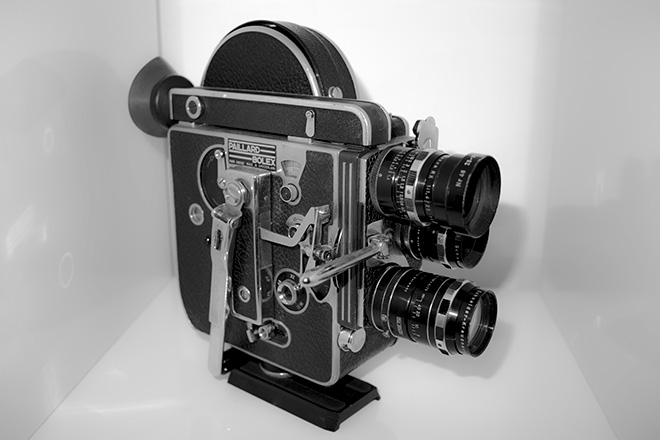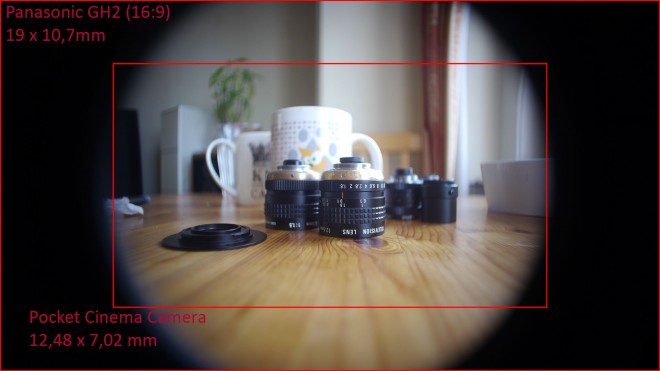
Above: EOSHD picked up this Bolex H16 for under 400 euros – it came with a complete set of Schneider Xenon lenses
I love the 16mm and Super 16mm format and there are two cameras on the horizon that could offer very exciting images. Digital Bolex with their global shutter, raw and extensive feature set then Blackmagic with their diminutive Pocket Cinema Camera which shoots ProRes and raw.
With only weeks to go until the expected Pocket Cinema Camera shipping data I’ve been stocking up on c-mount lenses. Here’s a guide to which ones work, which ones don’t, and how to spot a bargain.
The Blackmagic Pocket Cinema Camera and Digital Bolex feature Super 16mm sized sensors. This is a 3x centre crop of a full frame sensor. A full frame lens is designed to provide a large 36mm x 24mm sensor with coverage, therefore Super 16mm lenses can be physically smaller as the only need to cover a smaller 12.5mm x 8mm sensor (7mm on the Blackmagic when you take into account the crop to 16:9).
I’ve used c-mount lenses before on various cameras. The GH2 had a 1:1 crop mode that gave it an approximately Super 8mm sized sensor. The Nikon 1 mirrorless camera also took c-mount lenses and had a slightly larger than Super 16mm 1″ sensor.
The Blackmagic Cinema Camera’s sensor was half way between Micro Four Thirds and Super 16mm but the Pocket Cinema Camera and Digital Bolex sensors are perfectly matched and real Super 16mm. The mounts are also compatible – the Blackmagic Pocket Cinema Camera has a Micro Four Thirds mount and both cameras will take the original vintage 16mm glass via c-mount adapters.
At the edge of a lens you often get a brightness fall off (vignette), curving of bokeh and a softness to the image. Often these attributes are actually VERY attractive and cinematic. Cropping into full frame glass with your Super 35mm sensor or Micro Four Thirds sensor isn’t always desirable as you miss the edges of the image circle thus reducing the character of the lens.
Julian on the EOSHD forum has begun a monster thread taking contributions from around the world on which c-mount lenses are good on a Super 16mm sensor. To do this Julian came up with the idea for GH2 owners to test their c-mount lenses on the full sensor and crop a Super 16mm area out of the centre. This will tell you whether the lens covers the sensor on the Blackmagic and Digital Bolex Super 16mm cameras or not. Some which are designed for smaller 8mm, 16mm and digital CCTV CCD sensors or machine vision won’t work.

It is the vintage Super 16mm cine glass you should try and look for first and foremost. There’s some lovely stuff out there, albeit sometimes very expensive. The Switar 26mm F1.1 for example is the work of a spaceman but currently fetches upwards of $1000 on eBay.
I’ve found the best thing to do is to target the cameras themselves.
Often a seller will bundle lenses with a Bolex, and since some of these cameras have a turret, you can get as many as 3 lenses on the front of the camera for far less than you can buy them individually on eBay.
I found a CINE Xenon 16mm F2.0, 25mm F1.4 and 75mm F2.8 on my Bolex H16. These are very well built metal bodied lenses and suit the Pocket Cinema Camera because they are small and have buttery smooth short focus travels on the tiny barrel.
Some Super 16mm lenses, 25mm or longer even cover the Micro Four Thirds sensor of the GH3 but anything wider than 25mm generally won’t. The 75mm Xenon does cover it.
You will notice I am missing a wide angle in my bundle – the 16mm is actually a portrait lens equivalent to 50mm on full frame.
8mm and 10mm lenses are generally cheaper to get on eBay as none of them really work that well on Micro Four Thirds cameras, so a price bubble hasn’t quite formed. I was able to pick up a Kern Switar 10mm F1.6 for around 150 euros and it almost covers the 2.7x crop Nikon 1 sensor. I’m excited to use it on the Pocket Cinema Camera as it is a perfect match to the sensor. On the Nikon 1 the mild vignette was a nice soft edge at fast apertures which looked atmospheric but stop down to F5.6 and it becomes a harder black edge in the corners and that is not nice.
[vimeo]http://vimeo.com/36214357[/vimeo]Above: the Kern Switar 10mm F1.6 in action, as well as a few Computar TV lenses (25mm and 50mm F1.3)
One advantage of such a wide focal length like 8mm or 10mm is that focus becomes very manageable. You can stop down to F4, set it to infinity and everything from about 1-2m in front of you will be in focus – great for run and gun and one of the reasons Bolex cameras were so beloved by the French documentary / news movers and shakers of the 60’s and 70’s.
I’m looking for more contributions to the Super 16mm c-mount lens compatibility list started by Julian so if you have a Micro Four Thirds camera and c-mount lenses please do add to the list. Here is Julian’s list as it stands today. Some interesting stuff on this list.
Blackmagic Pocket Cinema Camera c-mount compatibility list
Yes = covers the full sensor of the Blackmagic Pocket Cinema Camera
No = doesn’t cover the sensor
Needs modification = Doesn’t fit on C-mount to M43-adapter without modifications
Equivalent = The focal length and depth equivalent on a fullframe camera (5D Mark III for example)
Primes
Apollo 25mm f/0.85 – YES = 72mm f/2.4 equivalent [link to proof]
Angenieux 10mm f/1.8 Retrofocus (Fixed Focus) – YES (dark corners) = 28,8mm f/5.2 equivalent [link to proof] [more info]
Carl Zeiss Jena Tevidon 10mm f/2 – YES – Needs modification = 28,8mm f/5.8 equivalent [link to proof] [more info]
Carl Zeiss Jena Tevidon 35mm f/1.9 – YES – Needs modification = 101mm f/5.6 equivalent [link to proof]
Century 9mm f/1.8 – YES (poor quality) [link to proof]
Computar 8mm f/1.3 – NO [link to proof]
Computar 16mm f/1.4 – NO [link to proof]
Computar TV Lens 25mm f/1.8 – YES = 72mm f/5,2 equivalent [link to proof]
Cosmicar 8,5mm f/1.5 – NO [link to proof]
Cosmicar 12.5mm f/1.8 – YES – Needs modification = 36mm f/5.2 equivalent [link to proof]
Cosmicar 25mm f/1.8 – YES – 72mm f/5.2 equivalent [link to proof]
Ernitec 6.5mm f/1.8 – YES (heavy distortion) [link to proof]
Ernitec/Navitar 17mm f/0.95 – YES (v. blurry corners & distortion) [link to proof]
Fujinon TV 12.5mm f/1.4 – YES (blurry corners) – Mod.? (unknown) = 36mm f/4 equivalent [link to proof]
Fujinon TV 16mm f/1.4 – NO [link to proof]
Fujinon TV 35mm f/1.7 – YES – Needs modification = 101mm f/4.9 equivalent [link to proof]
Leitz Macro Cinegon 10mm f/1.8 – YES (dark corners) = 28,8mm f/5.2 equivalent [link to proof]
Kern Switar 10mm f/1.6 – YES (slight vignette & blurry corners) [link to proof]
Nikon Cine Nikkor 13mm f/1.8 – YES = 37,5mm f/5.2 [link to proof]
Nikon Cine Nikkor 25mm f/1.8 – YES = 72mm f/5.2 equivalent [link to proof]
Pentax 25mm f/1.4 – YES – 72mm f/4 equivalent [link to proof]
Schneider 10mm f/1.8 (silver version) – NO (almost) [link to proof]
Schneider-Kreuznach Cinegon 11.5mm f/1.9 – NO (almost) = 33mm f/5.6 equivalent [link to proof]
Schneider-Kreuznach Cine-Xenon 16mm f/2 – YES = 46mm f/5.8 equivalent [link to proof] [link to proof (2)]
Schneider-Kreuznach Xenon 25mm f/0.95 – YES = 72mm f/2.7 equivalent [link to proof]
Schneider Xenoplan 17mm f/1.7 – YES (blurry corners) – [link to proof]
Tokina TV Lens 8mm f/1.3 – NO [link to proof]
Tokina TV Lens 16mm f/1.6 – NO [link to proof]
Taylor-Hobson Cooke Kinic 25mm f/1.3 – YES = 72mm f/3.7 equivalent [link to proof]
Taylor-Hobson 25mm f/1.9 – YES – 72mm f/5.6 equivalent [link to proof]
Wesley 25mm f/1.4 – YES = 72mm f/4 equivalent [link to proof]
Wollensak Cine Raptar 12.5mm f/1.5 – YES = 36mm f/4.3 equivalent [link to proof]
Wollensak Cine Raptar 25mm f/1.9 – YES = 72mm f/5.6 equivalent [link to proof]
$25 noname 25mm f/1.2 CCTV – YES = 72mm f/3.5 equivalent [link to proof]
Zooms
Ernitec 6-12mm f/1.4 – NO [link to proof]
Kowa TV Zoom 12.5-75mm f/1.8 – NO [link to proof]
————-
A word on crop factors
If you are used to full frame lenses, just bear in mind the crop factor. Super 16mm is a 3x crop of full frame so an 8mm lens in terms of full frame is a 24mm wide angle. 16mm is roughly 50mm for a standard portrait focal length, and a longer portrait focal length is 25mm which equals 75mm in full frame terms.
A c-mount 75mm lens meanwhile is a long 225mm telephoto focal length in full frame terms. So that’s what we’re dealing with here.
However crop factors should be approached with caution to avoid confusion. They can be a bit misleading as they imply the real focal length (in mm) of the lens changes. It doesn’t. A 28mm wide lens remains a 28mm, all that changes is the field of view which becomes a narrower crop – as it would if you cropped an image in post, or a photo in Photoshop.
A 28mm lens has a wide field of view (FOV) on a full frame sensor but isn’t wide angle on a small sensor. Wide angle on Super 16mm is 8mm. We’re so used to thinking in full frame field of view so we’ve taken to using a numerical crop factor to multiply the focal length of the lens, to give us an impression of what kind of lens it would behave like in full frame terms on a smaller sensor.
We’ve even taken to calling Super 35mm sensors ‘crop sensors’ since the influx of full frame Canon lenses into filmmaking. That has lead to some complaints from the film industry, who are used to Super 35mm as their standard, not full frame.
Super 35mm people think in terms of Super 35mm as being their 1.0x and they choose the right glass to suit the format. Super 35mm glass for Super 35mm, Super 16mm glass for Super 16mm. 8mm glass for 8mm. Arguably a lot more sensible than having to think in crop factors all the time.
Once you get used to matching the right glass to the sensor, you can forget about the crop factor.
Happy hunting people! And remember, try not to pay over the odds for fungus ridden crap. Some patience is required to build a collection and to prevent price bubbles from forming.


